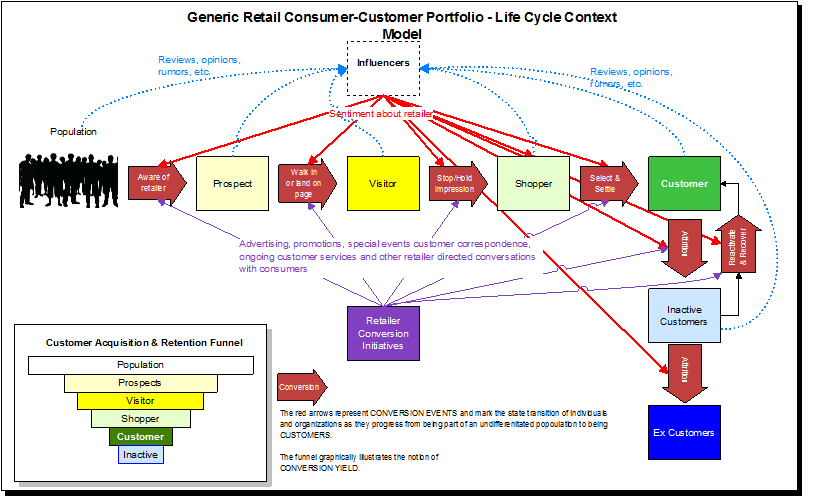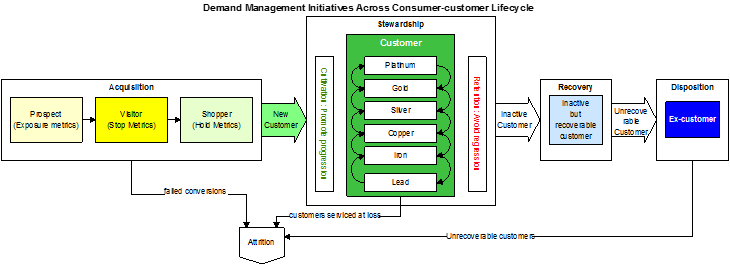Theme Concepts The Consumer-Customer Journey retail theme is brand new with ARTS Operational Data Model Version 7. The rationale for creating this retail theme is presented in the ARTS Consumer-Customer Lifecycle Analytics Technical Report. In ARTS ODM 6.1 and earlier versions, customers were modeled as subtypes of Party. With version 7, customer are modeled very differently. Customer RedefinedFirst, the notion of customer as a subtype of party is replaced by the notion that a person or organization's who buys retailer offerings is fulfilling a specific type of ROLE. A Person or Organization is represented as an abstract entity called Party in ARTS. A Party may take on many different roles (in the ODM 7 model role is represented by PartyRole) that define the nature of their conversations and interactions with the retailer. One of those roles is that of Consumer. A Consumer is any Party that purchases products and services. A Consumer may or may not purchase products and services from the retailer in the data model. Consumer-Customer LifecycleConsumers represent a kind of undifferentiated population of parties that buy things that retailers sell. The second concept introduced in version 7 is the consumer-customer journey. This journey in ARTS is conceptually represented as a state model. A state model provides entities, attributes and relationships to capture consumer states and state transitions. Consumer states and state transitions reflect their journey from being undifferentiated members of a population to becoming key customers of the retailer. By representing the journey as a state machine and building retail specific entities to describe different states and transitions between states, retailers can develop a storyline to portray consumer to customer journey. The consumer states and transitions, along with contextual data that describes stores, channels, reporting periods, promotions and the like, ARTS provides a much expanded view of retail consumer-customers that looks at them across their entire lifecycle. Customers become much more than an appendage to retail transactions. A Customer in ARTS is a consumer that has transitioned into a specific state - it is a state that is indicates that a consumer is trading with the retailer. The consumer to customer state transition is triggered by the consumer's first completed retail transaction. The diagram shown here illustrates a notational customer-consumer lifecycle. The different consumer states are represented by the colored rectangles connected by block arrows. Each block arrow represents a state transition. In retail marketing terms these transitions are called conversion events. Conversion events and the consumer state changes they engender are observed and captured as defined consumer behaviors. Along their journey, consumer behavior may be influenced by things a retailer does (Retailer Conversion Initiatives) and things other third parties say about the retailer and its offerings (Influencers). The sequential state transition view can recast as a customer acquisition and retention funnel. By joining the consumer states, conversion events, observed consumer behaviors together in a sequence it is possible to create individual consumer to customer journey story lines. This granularity of information offers retailers the opportunity to observe and measure how well their promotion and advertising initiatives are working. Like all stories, the ARTS consumer lifecycle has a beginning, a middle and an end. In the beginning there is the undifferentiated consumer. In the middle there is the prospect, visitor, shopper, customer and inactive customer. At the end all customer eventually pass away and become ex-customers. In the notational Consumer-Customer Life Cycle Model, the Ex-Customers are consumers that have stopped purchasing retailer offerings and cannot be reasonably expected to ever become active. Figure 20 - Consumer- Customer Life Cycle Model
|
Customer Lifecycle Sub-states
Customers may assume different sub-states as they trade with the retailer as illustrated in the Customer Lifecycle Sub-state Illustration. The diagram represents a demand management framework built around the ARTS customer lifecycle model. The sub-states for a customer are shown inside the Customer block. Retailers need to decide how customer states are defined and what behavioral criteria customers must meet to be assigned to a given sub-state. In the ARTS Consumer-Customer Lifecycle Analytics Technical Report a Customer Lifetime Value approach is explored. The purpose of this approach is to identify and grade the retailer's customers and invest promotional and customer service funds in customers who are most profitable or who are likely to increase in their profitability. The ARTS ODM Version 7.0/ 7.1 data model is designed to support this kind of analysis and to support the development of a retail customer portfolio. Figure 21 - Customer Lifecycle Sub-state Illustration
|

